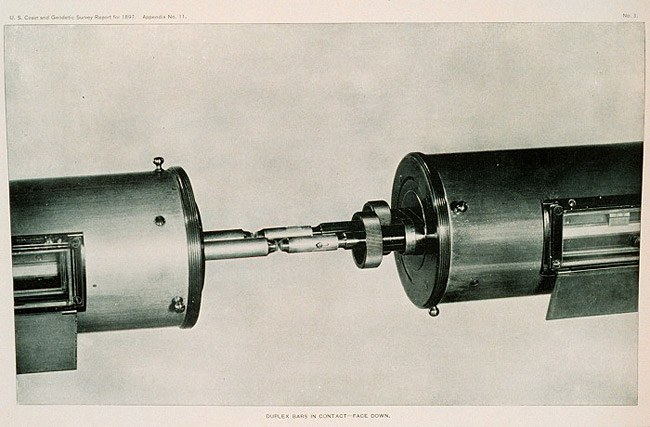 Great Theodolite
Great Theodolite The Bache- Wurdemann Compensating Device
The Bache- Wurdemann Compensating Device Eimbeck Duplex Bars
Eimbeck Duplex Bars Iced Bar B 17
Iced Bar B 17 Steel Tape with Tape Stretcher
Steel Tape with Tape Stretcher Invar Tape
Invar Tape AGA Geodimeter NASM-2A
AGA Geodimeter NASM-2A Tellurometer Model M/RA 1
Tellurometer Model M/RA 1 Laser Signal and Prismatic Mirror Reflecting System
Laser Signal and Prismatic Mirror Reflecting System AGA Geodimeters, Models 4D and 4L
AGA Geodimeters, Models 4D and 4L Big Red
Big Red AGA Geodimeter Model 6
AGA Geodimeter Model 6 Hewlett-Packard Model 3800B Distance Meter
Hewlett-Packard Model 3800B Distance Meter Tellurometer Model MA-100
Tellurometer Model MA-100 Ranger III and Rangemaster III
Ranger III and Rangemaster III Topcon ET-1 Total Station
Topcon ET-1 Total Station Trimble GPS Antenna
Trimble GPS Antenna
Eimbeck Duplex Bars
The Eimbeck duplex bar set was a device designed to resolve the problem of thermal expansion of metal rods used to measure distances. This photograph shows the ends of the Eimbeck duplex bars in contact. The ends of the bars were made of polished agate.

Ends of the Eimbeck duplex bars in contact. The ends of the bars were made of polished agate.
In the 1890s, Coast Survey Assistant William Eimbeck developed the Eimbeck duplex bars. Each of the bars was composed of two tubes, one of brass and one of steel, that were unconnected, nickel-plated, and enclosed by a double jacket of metal. The bars were designed so that they would absorb and emit heat equally and all changes in length due to heat expansion would be at a standard, known rate.
The Eimbeck duplex bars also included thermometers. In theory, the thermometers were not necessary and the bars could be used without them; however, testing done during work on the great arc of triangulation along the 98th meridian showed that it was best to use the thermometers. Conducted between 1897 and 1907, the 98th meridian survey was 1,720 miles in length and was the first great north-south arc in the U.S.
Historical Reference
Eimbeck was so pleased with his creation that, in an 1897 report, he stated,"On account of compactness of construction the duplex proved in this first trial to be not only a portable but also a most convenient field measure... If used ... without thermometers, the apparatus is simplicity itself." Since the bars were each five meters long, weighed more than 100 pounds apiece, and were carefully "leap-frogged" forward and read by several men in a surveying ballet that involved multiple readings of scales, levels, etc., it is hard to imagine what Einbeck's idea of "complex" would be!
- Distance Measurement Instrument Shown: Eimbeck duplex bars
- Location: Unknown
- Manufacture Date: 1890s
- Dates of Use: Late 1800s - Early 1900s
- Photo Date: 1897
Works Consulted
Baldwin, A. L. (1902). On the Measurement of Nine Bases Along the Ninety-Eighth Meridian [Electronic version]. Report of the Superintendent of the Coast and Geodetic Survey Showing the Progress of the Work from July 1, 1900, to June 30, 1901, pp. 229-301.
Dracup, J. F. Geodetic Surveys in the United States 1807-1940. Retrieved May, 2006, from: http://www.ngs.noaa.gov/PUBS_LIB/geodetic_survey_1807.html.
Eimbeck, W. (1897). Report on the Measurement of the Salt Lake Base Line in Utah. [Electronic version] Appendix No. 12, 1897, p. 757-758.
Jäderin, E. (1893).On the Measurement of Base-Lines with Steel Tapes and with Steel and Brass Wires [Electronic version]. Report of the Superintendent of the Coast and Geodetic Survey for the Fiscal Year Ending June 30,1893, Part II, pp. 125-164.
Related Web Sites
